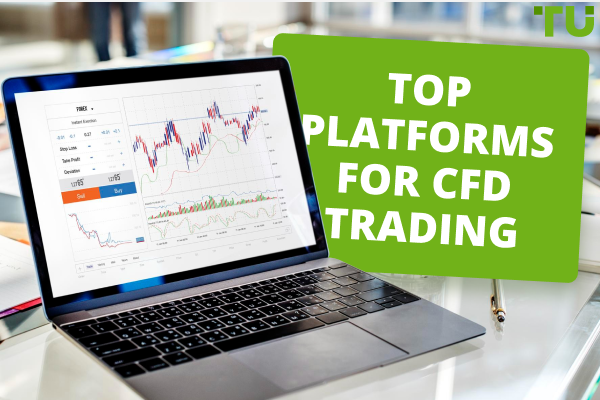CFD Trading vs Investing: Which Should I Choose?
When it comes to the trading realm, you have plenty of options. Nevertheless, you must take the time to fully understand them before making a decision. For instance, CFD trading and investing accounts are two highly popular, but also vastly different, methods of partaking in the investment realm. Nevertheless, each of these investment methods is highly beneficial in its own way. With that in mind, the following is a closer look at the differences between CFD vs invest accounts, as well as tips for choosing the best one for your financial goals.
Do you want to start CFD trading? Open an Account on eToro!What is CFD?
For those who are yet unfamiliar, CFD stands for a Contract For Difference. They are derivative products that allow investors to profit from the asset’s price movement without actually owning it. In other words, the CFD serves as a contract that asserts the buyer must pay the seller the difference between the present value of the asset and the value of the asset at the time in which the contract was originally signed. This means that the contracts do not factor in the asset’s underlying value; rather, they focus solely on the price between trade entry and exit.
By creating a contract between the client and the broker, these deals are created without the use of any forex, stocks, commodities, or futures exchanges. Nevertheless, given that they have unique advantages, CFDs have become highly popular in recent years.
What is CFD Trading?
On the other hand, CFD trading is the process of buying and selling CFDs. These contracts allow you to speculate and estimate price movements while mimicking a traditional trade that makes a profit as the market continues to rise or creating a CFD that will profit as the market decreases. When focusing on CFDs when the market decreases, this is considered ‘going short,’ while investments that involve market increases are considered ‘going long’.
Either way, investors are essentially making bets on whether or not the present value of the CFD will rise or fall. Here is a short list of the steps required to trade CFDs:
Select a Market: The first step is choosing which market to focus on.
Choose to Buy or Sell: Choose ‘buy’ if you think the price will rise in value or ‘sell’ if you think the price will decrease.
Select Trade Size: 1 CFD is equal to 1 share. You must choose the number of CFDs you want to trade.
Add a Stop Loss: Next, you need to create an order to close your position out at a specific price to protect you in case the price moves too far away from your initial investment amount.
Monitor and Close: After your trade has been placed, you can monitor the profit/loss update in real-time. You can exit anytime you wish by clicking the ‘trade’ button.
Pros and Cons of CFDs
In order to truly decide if you want to invest in CFDs vs. invest accounts, you need to understand their pros and cons. They are as follows:
Pros:
Global Market Access: One of the top benefits of investing in CFDs is that they allow you to gain access to the global market on one convenient platform. Since many brokers offer international product options, this allows investors around-the-clock access. This means you can trade CFDs in a wide array of markets.
Higher Leverage: Moreover, CDFs provide investors with higher leverage than when dealing with traditional trades.
Shorting Rules and Borrowing Stock Excluded: There are market rules that prohibit shorting. This means that the trader is required to either borrow instruments before selling short or they must have separate margin requirements for long and short-term positions. Either way, the rules prohibit traders from shorting any time without borrowing costs because the asset is not owned by the trader.
Day Trading Requirements Excluded: Although certain markets require a minimum amount to day trade or choose to place limits on how many day trades can be made on certain accounts, the CFD market is bereft of those restrictions. This means that all account holders can day trade if they so choose. CFD accounts can be opened with as little as $1,000, but many trading platforms require a minimum of $2,000 or even $5,000.
No-Fee Professional Execution: Moreover, CFD brokers offer many of the same order types that are normally offered by traditional brokers. This includes stops, limits, contingent orders, and much more.
Various Trading Opportunities: Brokers offer index, stock, treasury, sector, and commodity CFDs. This makes it possible for investors to create a diverse portfolio including an array of investment types.
Cons:
Risks: One of the top disadvantages of CFDs is that they come with a high level of risk. Therefore, there are liquidity risks and margins that must be maintained. Those who are unable to cover reductions in value may have their positions closed by their providers.
Weak Regulations: Although the market is preferred by many due to the lack of overwhelming restrictions, these weak regulations do not always work in favor of the investor. If you are not dealing with a reputable, trusted dealer, you could be a victim of a crafty expert that exploits loopholes to make money off of you and your investments.
Traders Pay the Spread: Since CFDs require traders to pay the spread on exits and entries, it is much more difficult to profit from smaller moves.
Lack of Ownership: The fact that you don’t actually own the asset means that you may not benefit from certain successes had by the company.
Cost of Overnight Financing: Lastly, overnight financing costs may kick in overnight. These costs may mount up rather quickly.
What is Investing?
On the other hand, investing means that you are literally buying shares in an ETF company. This gives you direct ownership over a certain number of shares of any given asset. This allows investors to directly benefit from any increase in the share price over time. Likewise, they also stand to lose in the event of a price decrease. Moreover, depending on the number of shares you purchase, you may also be able to get dividends and voting rights.
Some of the most common investment strategies are:
-
Value Investing: This strategy involves seeking out stocks that are undervalued and purchasing them at a discounted price to hopefully gain a profit over time.
-
Growth Investing: On the other hand, growth investing involves seeking out stocks that have strong potential for growth. These stocks are not undervalued; rather, they are attached to companies that are expected to experience exponential growth in the future.
-
Momentum Investing: Momentum investing involves seeking out stocks that are experiencing an uptrend. On the other hand, they may also seek out stocks that are on a down-trend in order to short sell them.
Pros and Cons
If you are interested in going the more traditional route, here are the pros and cons of investing:
Pros:
Simple to Buy/Understand: Investing in stocks is a simple process that is easy to understand. You can purchase and sell them online, using apps, via a broker, or even a financial planner.
Earn as the Economy Grows: Also, by investing in stocks, you are able to benefit as the economy grows. By taking the time to learn about which sectors are growing and flourishing, you can invest in companies that are a part of these budding sectors.
Get Ahead of Inflation: Since most stocks have a 10% annual return, this allows investors to get ahead of inflation, which is typically lower than that.
Two Ways to Make Money: Although buying low and selling high is the most common goal; this can be achieved in a couple of ways: day trading and buy and hold investing.
Simple to Sell: Lastly, you can sell them as easily as you buy them.
Cons:
Risks: Investing in traditional stocks is always a risk. You could make money, or you could lose it all.
Pay Walls: Although you can invest without professional help, this also leaves you without the tools and assistance often needed to make substantial gains.
Stockholders are Paid Last: Additionally, unless you are a preferred stockholder, bondholder, or creditor, you will be paid last if the company goes broke.
Research: In order to make substantial gains, you need to take lots of time to research the various aspects of the companies/sectors you plan to invest in.
Market Fluctuation: The market is known for wild fluctuations. At times this can cause stress and can even cause you to miss out on great investment opportunities.
Top 5 Differences Between Investing and CFD Trading
Now that you know more about CFDs and Trading, here are the top 5 key differences:
Period
A trader's periods are from a few seconds to 2-3 months, while investors' horizons are from a year to many years. This is because CFDs are more conducive to shorter-term gains, while investing is meant to allow you to slowly accumulate wealth over a period of many months or years.
Market Analysis
Traders primarily use technical analysis and statistical patterns to identify short-term trends. The investor's approach is an approach to identifying undervalued assets based on an analysis of financial performance. This is known as the Buffett approach.
Risks
The risk of trading CFDs is significantly higher than investing. Broker’s statistics say that nearly 70-75% of accounts lose money. This is because investors mainly form diversified portfolios, which reduce risks, but does not eliminate them.
Expected Return
Nevertheless, the profitability of trading can amount to hundreds of percent per year, while this is almost impossible in investing. Usually, investors receive 10-20% per annum.
Time spent
Trading, especially active day trading, is like a business. It requires a constant presence in the market. At the same time, investing can be combined with other work without prejudice.
Investing vs CFD Trading - Which is Better For Me?
On the one hand, investing is suitable for almost anyone who wants to secure a future through capital growth. A portfolio can be formed, for example, from index funds. On the other hand, CFD trading is suitable for people who are willing to spend a lot of time learning and practicing to make trading a business. So, while the potential profit of trading is higher, it is also worth taking the significant risk into account.
Best Brokers For CFD Trading and Investing
If you are searching for top-notch CFD trading and investing brokers, there are plenty to choose from. However, here are three of the top ones:
XTB
If you are searching for premium brokers, XTB may be it. Placing emphasis on customer support and providing them with the educational tools needed to succeed, XTB has its negatives and positives.
On the plus side, the platform is regulated by FCA (U.K.), offers the lowest FX spreads, offers protection for client accounts, and has outstanding customer service. However, the platform does not accept clients from the United States, there is no guaranteed stop loss, non-FX costs are high, and there are no back-testing or automated trading capabilities.
eToro
On the other hand, eToro is a broker that allows users to trade crypto CFDs, over 40 crypto assets, and more. On the pro side, eToro is a well-established platform that is regulated in numerous jurisdictions, and they allow you to choose from various cryptocurrencies and CFDs. However, It is not very beginner-friendly, has high minimum trading requirements, and they have a complex fee structure.
ActivTrades
Lastly, ActivTrades is a global forex broker that was founded in 2001. On the pro side, they offer low trading fees, free deposits, and withdrawals, and offer excellent account opening services. On the con side, the research tools are considered subpar, they have a relatively small product portfolio, and they do charge fees for extended periods of inactivity.
Summary
Overall, whether you should choose to trade CFDs or traditional investing depends on various factors. In the end, it boils down to how much risk you are willing to take on and whether you prefer short-term or long-term investments. Either way, both can be quite lucrative when you take the time to do your research and work with the best brokers.
FAQs
In what countries can you trade CFDs?
The United Kingdom, Germany, Switzerland, Singapore, Spain, France, South Africa, Canada, New Zealand, Hong Kong, Sweden, Norway, Italy, Thailand, Belgium, Denmark, and the Netherlands. Australia has allowed them but is making changes for the future. The US does allow non-residents to trade using them.
Why are CFDs not tradable in the United States?
The main reason is that it is considered an over-the-counter product that is not well regulated, which makes them problematic and high risk.
How much does it cost to get a seat on the NY Stock Exchange?
It costs millions. The highest was $2.65 million, in 1999.
Can you lose all your money dealing with only traditional investments?
Although there is much more transparency, yes, you can lose your total investment amount even if you invest solely in traditional stocks.
Team that worked on the article
Mikhail Vnuchkov joined Traders Union as an author in 2020. He began his professional career as a journalist-observer at a small online financial publication, where he covered global economic events and discussed their impact on the segment of financial investment, including investor income. With five years of experience in finance, Mikhail joined Traders Union team, where he is in charge of forming the pool of latest news for traders, who trade stocks, cryptocurrencies, Forex instruments and fixed income.
The area of responsibility of Mikhail includes covering the news of currency and stock markets, fact checking, updating and editing the content published on the Traders Union website. He successfully analyzes complex financial issues and explains their meaning in simple and understandable language for ordinary people. Mikhail generates content that provides full contact with the readers.
Mikhail’s motto: Learn something new and share your experience – never stop!
Dr. BJ Johnson is a PhD in English Language and an editor with over 15 years of experience. He earned his degree in English Language in the U.S and the UK. In 2020, Dr. Johnson joined the Traders Union team. Since then, he has created over 100 exclusive articles and edited over 300 articles of other authors.
The topics he covers include trading signals, cryptocurrencies, Forex brokers, stock brokers, expert advisors, binary options. He has also worked on the ratings of brokers and many other materials.
Dr. BJ Johnson’s motto: It always seems impossible until it’s done. You can do it.
Mirjan Hipolito is a journalist and news editor at Traders Union. She is an expert crypto writer with five years of experience in the financial markets. Her specialties are daily market news, price predictions, and Initial Coin Offerings (ICO). Mirjan is a cryptocurrency and stock trader. This deep understanding of the finance sector allows her to create informative and engaging content that helps readers easily navigate the complexities of the crypto world.












